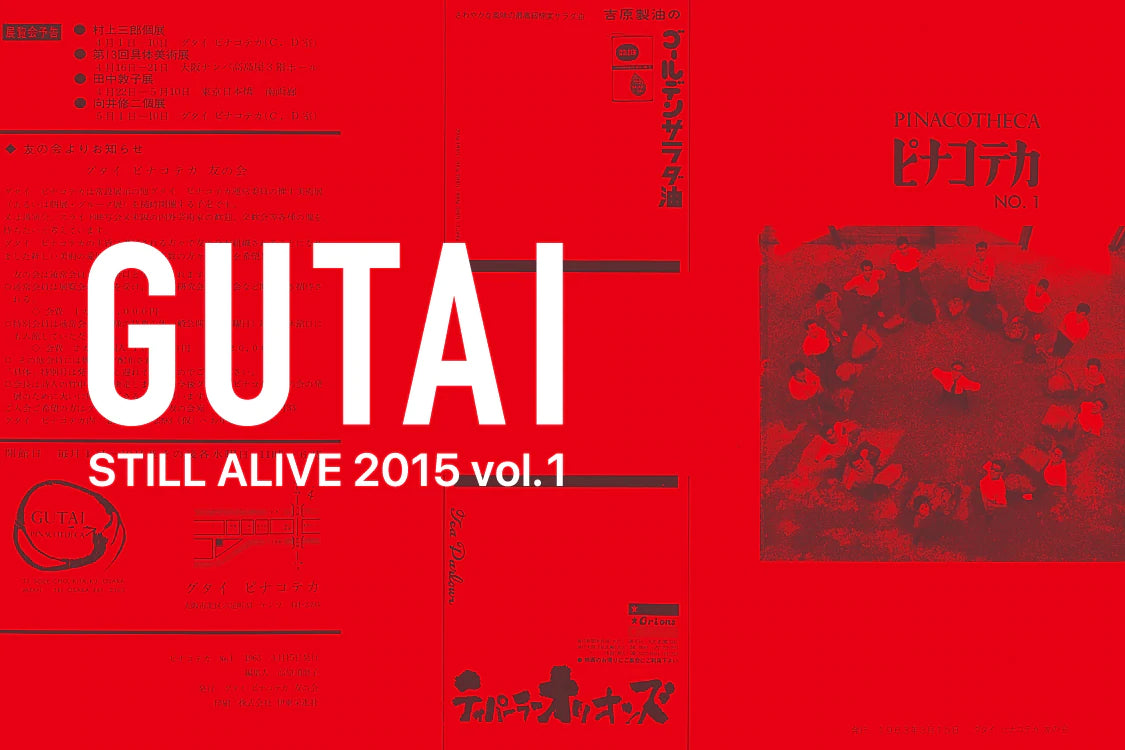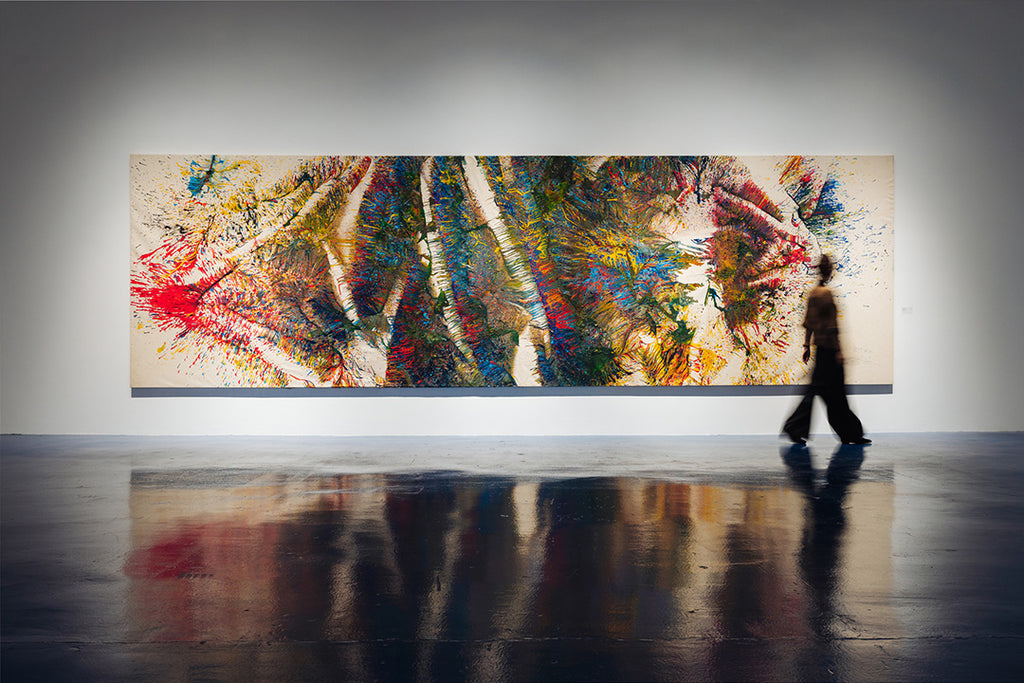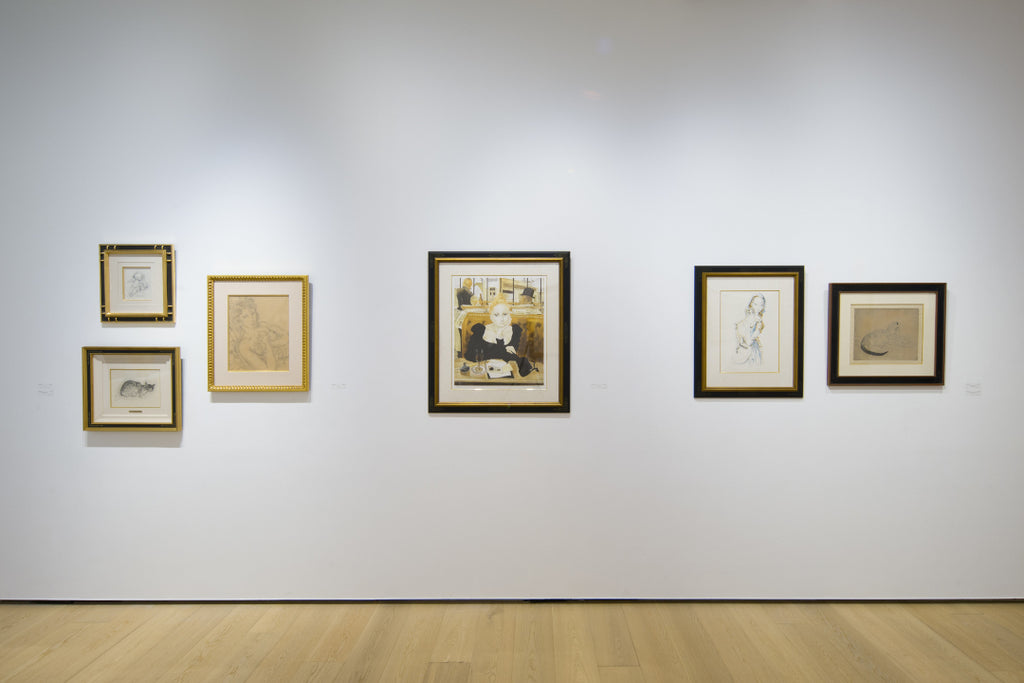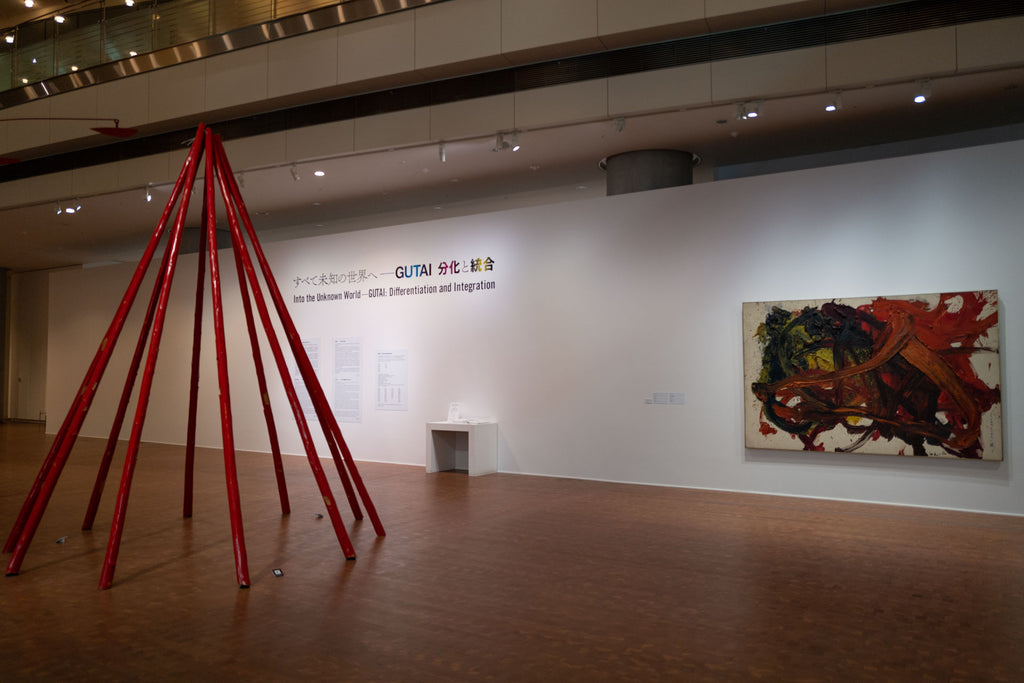ARTICLES
藝術家前川強眼中的具體美術與獨創性
GUTAI STILL ALIVE 2015 vol.1
12/35

本系列企劃為您推出關於具體美術協會的書籍《GUTAI STILL ALIVE 2015 vol.1》的數字檔案。第12期介紹被稱為「具體第二代」的藝術家之一、前川強與美術史學家本江邦夫的對談。在對談中,兩人就前川所目睹的吉原治良的真實面貌,以及在具體美術協會中最被重視的獨創性進行了交談。
「具體第二代」藝術家的分享—— 具體美術與吉原治良的真實面貌
對談:前川強 本江邦夫
現在具體美術再次受到世人矚目。「具體」藝術家不但在日本國內外的眾多美術館得以介紹和推崇,而且他們的作品也在拍賣會上屢創高價。雖然領軍人物吉原治良、白髮一雄、田中敦子等人已不在人世,但人們仍然關注著上前智祐等具體解散之後依然堅持創作的藝術家。本期我們邀請到被稱為「具體第二代」的前川強作為嘉賓,深入探討「具體」藝術的真實面貌。
從現代美術到具體美術
本江:前川先生,您真是文雅脫俗、時尚有品。感覺您更像是一位設計師而不是畫家。
前川:其實我以前也做過平面設計師。
本江:果不其然!您從具體美術協會的第8屆展覽會開始便一直參與其中,首先您能不能談談加入協會的詳細經過?
前川:我一開始是嚮往現代美術協會,作品大概參展了二、三次。在高中時,我的學長有早川良雄先生和中村真先生,我常去他們的工作室或家裡玩。後來,我有緣結識了同樣在現代美術展覽會參展的嶋本昭三先生、上前智祐先生、鷲見康夫先生,由於他們的作品也在具體美術協會參展,我便得知了具體美術的存在。因此便有人說「為什麼不請吉原先生看一下你的作品呢?」,然後事情就朝著這個方向發展了。
本江:您第一次看到「具體」的展覽會時,印象怎麼樣?
前川:我覺得「這可真是個有趣的地方啊」,與其他群體完全不一樣。
本江:任何人都可以參展嗎?
前川:可以是可以的,但需要讓吉原老師過目,如果他說好,那就可以正式展出。
本江:原來如此。順便問一下,聽說您曾經用卡車把作品送到吉原治良家,結果撞壞了大門,這是真的嗎?
前川:這麼一說,確實也曾發生過這樣的事情。不過,由於那是一座相當古老的房子,稍微撞壞一點兒,是不會有人察覺到的(笑)。
本江:您那時候有多大?
前川:當時剛剛高中畢業,所以是19歲。
本江:您的發展相當早熟啊。具體美術協會成立於1954年,您(1936年生)在61年成為會員。根據資料,您與松谷武判(1937年生)、向井修二(1940年生)等人一起,定位是「具體第二代」。當時,吉原治良應該是50歲左右。
前川:最初對具體予以認可的是米歇爾·塔皮耶(法國美術評論家),他當時好像對吉原先生說:「不要再增加成員了」,但因為協會的氣氛開始有那麼一點兒固步自封的老氣,所以有人便提出「那麼就加一些年輕人吧」。我成為會員,花了4、5年的時間。
本江:自那以後您一直都是「具體」的成員嗎?
前川:直到協會解散為止,我一心一意地始終都是「具體」的會員。
往日的具體美術
本江:您能介紹一下「具體」當時的情況嗎?
前川:當我開始參展的時候,一本名叫《Idea》的設計雜誌曾對具體美術進行過專題報道。我當時就覺得「這已經是超越美術的事情了」。具體美術確實是一個非常神奇的團體,以至於讓我這麼想。在接觸「具體」之前,我曾經去過各種畫廊,看過一些公開徵集作品的展覽,但在參與「具體」之後,就再也沒有這麼做了。「具體」肯定擁有與眾不同的東西。
本江:有那麼厲害嗎?是什麼讓它如此與眾不同呢?
前川:團體本身的特立獨行當然是一個因素,而且每個成員都完美地具有自己獨特的風格和才華。白髮一雄就是白髮一雄,元永定正就是元永定正,每個人都非常獨特。如此與眾不同的團體,除了「具體」以外,以前不曾有,後來也不會有。
本江:您一直都是「具體」的成員嗎?
前川:是的,從20多歲開始就一直是。
本江:這樣的成員很罕見嗎?
前川:並不罕見,中途退出的人反而很罕見。田中敦先生和金山明先生於1965年退出,還有在大阪世博會期間發生了一些事情,元永定正先生和村上三郎先生也退出了。大概在世博會結束兩年後,吉原先生去世了,大家都覺得沒辦法,放棄吧,於是就決定解散了。
本江:吉原先生確實是一個絕對性的存在嗎?
前川:是絕對性的。從年齡上來說也是這樣的,而且他當時就已經是一位名人了。
本江:那麼,您和吉原先生之間有過激烈的爭論嗎?
前川:我們從來沒有激烈爭論過。從他的角度來看,可能是覺得像對待孩子一樣吧(笑)。但我從來沒有被當做孩子對待過。如果我請求他看我的畫,他即使把手頭的工作放下來,也會認真看的。
本江:您請求吉原先生看畫的時候,是怎麼樣的一種情況呢?
前川:我們經常聚在位於中之島的吉原先生的家裡或者他在蘆屋市的別墅里。大家坐在榻榻米上聽他講話。他的主宅院子里有一個老式庫房,那裡存放著會員們頗受矚目的作品,每當外國客人來訪時,我們就把這些作品擺出來展示。
本江:成員之間的關係如何?是相互激發啟迪的感覺嗎?
前川:我們經常會聊起「在這次展覽中誰最出色」之類的話題,但平時並不像其他團體那樣相互激發啟迪。與其他團體相比,具體的成員之間很少談論創作。就像創作只是為了向吉原先生展示作品那樣。與其說相互激發啟迪,不如說直到展覽開幕的那一刻,我們更注意相互保密。我認為大家的競爭意識非常強烈。
本江:順便問一下,有一段時間,具體在歐洲引起了轟動,很多日本的行為藝術家都去了那裡。由於這一原因,提到「具體」一詞,在人們的心目中,他們屬於行為藝術家的印象更深,您對此有何看法呢?
前川:就個人而言,我本來就有「望以畫論事」的想法,所以我一直以冷靜的眼光看待這一切。而且當我加入「具體」時,好像大家都停止了這樣的表演,開始專心作畫了。
本江:一開始曾有過各種嘗試,但最終整體上是以作畫成為主導的,是這樣嗎?
前川:最初的野外展覽之類的活動不再有了。對了,日前在古根海姆美術館的具體展上重現的「卡片盒」活動,是曾在第11屆具體展上舉辦過的。
本江:卡片盒是什麼?
前川:有人藏在一個盒子裡面,當你往盒子里投入10日元硬幣時,它就會吐出一張卡片。在最後一天,會員們對我說「你也試試吧」,於是我排在最後把錢投進去後,就出現了這張卡片。
本江:這是吉原先生的字嗎?
前川:吉原先生想給我一個驚喜,非常努力地做了這件事。此外,我還得到了他的推薦信,沒有人得到過這樣的推薦信,只有我一個人(笑)。
本江:這可是只有曾在「具體」內部待過的人,方可知曉的趣聞軼事,也是一個講述吉原治良先生人品的好故事。
使用麻袋布的創作
本江:我想了解一下您本人的創作。您經常使用麻袋布,即一種粗糙的麻布,這是從什麼時候開始的呢?
前川:我一直喜歡粗糙狂野的布料手感,在現代美術協會也用這種風格的作品參展,將麻布剪成類似褶皺的作品是從1962年左右開始創作的。但是,因為還有其他幾個使用麻袋布的藝術家,而我想創作出與他們不同的作品,所以遇到了許多困難,也沒少吃苦。
本江:這是縫製的嗎?
前川:我用縫被子的針縫製的。不過,後來發現其實用Bond黏合劑也能粘得很牢固(笑)。
本江:「抓縫」是什麼樣的縫法?
前川:把布抓起來用縫紉機縫製。抓起來的那部分的邊緣總會多出來吧。那就將其伸展並拉平。看看這個就會明白吧。
本江:縫的是哪裡?啊,仔細一看就明白了。真的,的確是縫著的。
前川:過了一段時間就會收縮。這時候褶皺會出現在某個地方,但會在拉伸的過程中消失。這很麻煩費力,但特別有趣。
本江:確實是一項很費力的工作。對了,您在80年代獲得了很多獎項吧?
前川:我靠這個系列得了不少獎。把褶皺都推到邊緣,讓其消失,這種技法當時成為一個熱門話題。另一件作品是把布料弄得皺皺巴巴,然後在上面塗了很多顏料。粗略地混合之後再拉伸,就會出現縫隙,產生有趣的空間。
本江:原來如此。這是在「具體」解散之後創作的嗎?
前川:是的。「具體」解散之後,必須自己決定要幹什麼,所以我就開始做這個。但也不能只做這個,於是我就改變了創作方法。
本江:您為什麼這麼想在畫面上弄出凹凸不平的效果呢?
前川:最主要的原因是我想顯示出與其他用麻袋布進行創作的美術家的不同。有的人是塗抹顏料,有的人操刀雕琢,有的人展現褶皺。而我是讓Bond黏合劑滲進麻袋布。這樣就能形成非同尋常的形狀。這可以說是在追求了充分發揮其特性的表達方式之後才出現的結果。
本江:麻袋布是買的嗎?
前川:現在是買的,但過去並不容易買到,所以我就求人,讓他們把米袋或用過的舊麻袋分給我使用。這也十分有趣。有的作品只是讓麻袋布膨脹了起來。但自從我意識到諸如「不對啊,這看起來像某人的作品」這樣的事情以後,就把它放進倉庫裡。等過了一段時間,當我將其拿出來並撕破後,便得到了一個非常有趣的形狀。從那之後,我就開始在作品上開孔。
本江:原來如此。
前川:這個是用網狀物拼接而成的。布料的染色都是我自己做的。色彩很漂亮吧?
本江:形狀的依據是什麼呢?
前川:也許是簡化吧。盡可能地使作品保持簡單,創造出沒有被使用過的形狀。
本江:是不是看到一個具體的什麼東西之後進行簡化並使其抽象呢?
前川:並非如此。後來從結果來看像一座山之類的情況倒是有的。
本江:瀨木慎一先生曾在一篇隨筆中就您寫道:「這位畫家的創作理念是:人是皮膚,世界是表皮,繪畫也是表面。」我對此十分欽佩。這是您說的話嗎?
前川:不,我想那是瀨木先生對我的感受。我為此十分感激。
對「具體」的重新評價
本江:現在,「具體」再次引人矚目,您對此是怎麼看的呢?
前川:感覺像是在做夢一樣。吉原先生曾經常開玩笑地說:「你很快就會大賣的。」 實際上確實如此,儘管經過了幾十年(笑)。
本江:您曾考慮過放棄創作嗎?
前川:一次也沒有。不知為什麼,反而是如果參加比賽落選的話,雖然會很失望,但也會更加激發出成倍的幹勁兒。
本江:作為一名具體畫家的自尊也是一個因素嗎?
前川:當然也有自尊,但即使我一個人單獨活動,可能也會是這樣的。不過,對我來說,曾是「具體」的一員就意味著幾乎所有一切。
本江:您作為美術家的精神境界很高吧。
前川:我們做的事情在外國得到了承認,這給我們帶來了很大的自信。海外人士誇贊說「這是自浮世繪以來,日本美術再次受到舉世矚目」。他們指出「具體有獨創性,這才是真正的美術」,如其所說,其他美術作品都是在模仿別人。就像是說「這是雷諾阿,這是郁特里羅,這是某人」那樣。
本江:因為在海外的評價也高吧。
前川:當時在歐洲同時出現的從事不定形藝術創作的人曾說過「『具體』是在模仿我們」。但現在他們又表示「我們還是認可『具體』的」。即使有人說「這幅作品是向抽象表現主義的致敬」,但也有人會反駁說「不對,『具體』出現得更早」。因此,這種自豪感還是有的。即便不是自己的作品,但只要具體成員的作品得到高度評價,我都會感到特別高興,而且希望能永遠身在其中。
本江:即使現在看「具體」的作品展,也不會覺得已經過時。這可能還是「具體」的獨創性發揮了作用吧。
前川:過去曾經被人說過:「你怎麼知道那是獨創性呢?世界如此之大,也許早就有人在某個地方做同樣的事情了。」正因為如此,我從一開始就放棄了爭辯。即使有人做同樣的事情,但只要敢於拼搏就可以了。我認為這不僅是我的,而且也是具體藝術家特有的氣魄和理念。
本江:的確如此,也許正是每一部作品中蘊含著的這樣的理念促成了對「具體」的重新評價。這真是強烈希望讓現在的年輕畫家們傾聽的一席話。期待您今後也能大顯身手。今天非常感謝您的合作。
(刊登於《美術月刊》2013年8月號)
*文中提到的資訊是文章發佈當初的情況,某些部分也許已與現狀有所不同。
ARTIST
RELATED ARTICLES
-

First Chapter: What Is Contemporary Art, and How Does It Deepen Our Way of Looking at Art?
2025.12.15
FEATURE -

行動繪畫的真相 | 嶋本・白髮的精神與國際聲譽
2023.08.31
訪談 -

在香港探索巴黎畫派畫家藤田嗣治的傑作
2023.02.10 香港
ART NEWS -

50 Years Since the End | The Gutai Art Association as seen at the National Museum of Art, Osaka
January 4, 2023
ART NEWS



